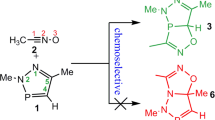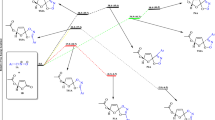Abstract
The mononuclear and binuclear mechanisms of Ag(I)-catalyzed azide-alkyne cycloaddition (AgAAC) reaction of benzyl azide with phenyl alkyne in gas phase and the presence of toluene as a solvent for formation of the 1,4-disubstituted 1,2,3-triazoles have been investigated by DFT calculations using MN12-L and MN15-L functionals with both basis sets Def2-TZVP including a pseudopotential for Ag and Def2-SVP for the mean elements. The effect of the PPh3, 2-(diphenylphosphaneyl)-N,N-diisopropylbenzamide, and 2-(di-tert-butylphosphaneyl)-N,N-diiso-propylbenzamide (L1, L2, and L3) as ligands on the catalytic cycle has been studied in both mononuclear and binuclear pathways. DFT calculations with MN12-L and MN15-L functionals show that the AgAAC reaction favors the mononuclear pathway by comparison with the uncatalyzed reaction for the formation of 1,4-regioisomer. On the other hand, in the AgAAC reaction, the comparison between the mononuclear and binuclear pathways indicates that the free energy barrier of the mononuclear paths is higher than that of the binuclear cases for L1 ligand, and vice versa for L2 and L3 ligands.










Similar content being viewed by others
Change history
30 December 2022
A Correction to this paper has been published: https://doi.org/10.1007/s11144-022-02333-4
References
Michael A, Auf UDEVD (1893) Acetylendicarbonsäuremethylester. J Prakt Chem 48:94–95
Huisgen R (1963) 1,3-Dipolar cycloadditions. Past and future. Angew Chem Int Ed Engl 2(10):565–598. https://doi.org/10.1002/anie.196305651
Tornøe CW, Christensen C, Meldal M (2002) Peptidotriazoles on solid phase: [1,2,3]-triazoles by regiospecific copper (I)-catalyzed 1,3-dipolar cycloadditions of terminal alkynes to azides. J Org Chem 67(9):3057–3064. https://doi.org/10.1021/jo011148j
Rostovtsev VV, Green LG, Fokin VV, Sharpless KB (2002) A stepwise Huisgen cycloaddition process: copper (I)-catalyzed regioselective “ligation” of azides and terminal alkynes. Angew Chem 114(14):2708–2711. https://doi.org/10.1002/1521-3773(20020715)41:14%3C2596::aid-anie2596%3E3.0.co;2-4
Boren BC, Narayan S, Rasmussen LK, Zhang L, Zhao H, Lin Z, Fokin VV (2008) Ruthenium-catalyzed azide−alkyne cycloaddition: scope and mechanism. J Am Chem Soc 130(28):8923–8930. https://doi.org/10.1021/ja0749993
Johansson JR, Beke-Somfai T, Said Stålsmeden A, Kann N (2016) Ruthenium-catalyzed azide alkyne cycloaddition reaction: scope, mechanism, and applications. Chem Rev 116(23):14726–14768. https://doi.org/10.1021/acs.chemrev.6b00466
Wei F, Wang W, Ma Y, Tung CH, Xu Z (2016) Regioselective synthesis of multisubstituted 1,2,3-triazoles: moving beyond the copper-catalyzed azide–alkyne cycloaddition. Chem Commun 52(99):14188–14199. https://doi.org/10.1039/C6CC06194J
Wang C, Ikhlef D, Kahlal S, Saillard JY, Astruc D (2016) Metal-catalyzed azide-alkyne “click” reactions: mechanistic overview and recent trends. Coord Chem Rev 316:1–20. https://doi.org/10.1016/j.ccr.2016.02.010
Alemán Sierra E (2019). Síntesis Sostenible de Glicoestructuras con Aplicación en Procesos Infecciosos. https://doi.org/10.1016/j.tet.2019.05.046
Kalra P, Kaur R, Singh G, Singh H, Singh G, Kaur G, Singh J (2021) Metals as “Click” catalysts for alkyne-azide cycloaddition reactions: an overview. J Organomet Chem 944:121846. https://doi.org/10.1016/j.jorganchem.2021.121846
Presolski SI, Hong V, Cho SH, Finn MG (2010) Tailored ligand acceleration of the Cu-catalyzed azide−alkyne cycloaddition reaction: practical and mechanistic implications. J Am Chem Soc 132(41):14570–14576. https://doi.org/10.1021/ja105743g
Dumoulin F, Ahsen V (2011) Click chemistry: the emerging role of the azide-alkyne Huisgen dipolar addition in the preparation of substituted tetrapyrrolic derivatives. J Porphyrins Phthalocyanines 15(07–08):481–504. https://doi.org/10.1142/S1088424611003434
Wenska M, Alvira M, Steunenberg P, Stenberg Å, Murtola M, Strömberg R (2011) An activated triple bond linker enables ‘click’ attachment of peptides to oligonucleotides on solid support. Nucleic Acids Res 39(20):9047–9059. https://doi.org/10.1093/nar/gkr603
Nia AS, Rana S, Döhler D, Noirfalise X, Belfiore A, Binder WH (2014) Click chemistry promoted by graphene supported copper nanomaterials. Chem Commun 50(97):15374–15377. https://doi.org/10.1039/C4CC07774A
Cantel S, Halperin JA, Chorev M, Scrima M, D’Ursi AM, Levy JJ, Papini AM (2009) Side chain-to-side chain cyclization by intramolecular click reaction-building blocks, solid phase synthesis and conformational characterization. Peptides for Youth. Springer, New York, pp 175–176
Kamaruddin MA, Ung P, Hossain MI, Jarasrassamee B, O’Malley W, Thompson P, Graham B (2011) A facile, click chemistry-based approach to assembling fluorescent chemosensors for protein tyrosine kinases. Bioorg Med Chem Lett 21(1):329–331. https://doi.org/10.1016/j.bmcl.2010.11.005
Boisselier E, Salmon L, Ruiz J, Astruc D (2008) How to very efficiently functionalize gold nanoparticles by “click” chemistry. Chem Commun 44:5788–5790. https://doi.org/10.1039/B812249K
Jiang Q, Xiao N, Shi P, Zhu Y, Guo Z (2007) Design of artificial metallonucleases with oxidative mechanism. Coord Chem Rev 251(15–16):1951–1972. https://doi.org/10.1016/j.ccr.2007.02.013
McNulty J, Keskar K, Vemula R (2011) The First Well-Defined Silver (I)-complex-catalyzed cycloaddition of azides onto terminal alkynes at room temperature. Chemistry 17(52):14727–14730. https://doi.org/10.1002/chem.201103244
McNulty J, Keskar K (2012) Discovery of a robust and efficient homogeneous silver (I) catalyst for the cycloaddition of azides onto terminal alkynes. Eur J Org Chem 2012(28):5462–5470. https://doi.org/10.1002/ejoc.201200930
Connell TU, Schieber C, Silvestri IP, White JM, Williams SJ, Donnelly PS (2014) Copper and silver complexes of tris (triazole) amine and tris (benzimidazole) amine ligands: evidence that catalysis of an azide-alkyne cycloaddition (“click”) reaction by a silver tris (triazole) amine complex arises from copper impurities. Inorg Chem 53(13):6503–6511. https://doi.org/10.1021/ic5008999
Boz E, Tüzün NŞ (2016) Ag-catalyzed azide alkyne cycloaddition: a DFT approach. Dalton Trans 45(13):5752–5764. https://doi.org/10.1039/C5DT04902D
Banerji B, Chandrasekhar K, Killi SK, Pramanik SK, Uttam P, Sen S, Maiti NC (2016) Silver-catalysed azide–alkyne cycloaddition (AgAAC): assessing the mechanism by density functional theory calculations. R Soc Open Sci 3(9):160090. https://doi.org/10.1098/rsos.160090
Sultana J, Sarma D (2020) Ag-catalyzed azide-alkyne cycloaddition: copper free approaches for synthesis of 1,4-disubstituted 1,2,3-triazoles. Catal Rev 62(1):96–117. https://doi.org/10.1080/01614940.2019.1673443
Ortega-Arizmendi AI, Aldeco-Pérez E, Cuevas-Yañez E (2013) Alkyne-azide cycloaddition catalyzed by silver chloride and “abnormal” silver N-heterocyclic carbene complex. Sci World J. https://doi.org/10.1155/2013/186537
Ali AA, Chetia M, Saikia B, Saikia PJ, Sarma D (2015) AgN (CN) 2/DIPEA/H2O-EG: a highly efficient catalytic system for synthesis of 1,4-disubstituted-1,2,3 triazoles at room temperature. Tetrahedron Lett 56(43):5892–5895. https://doi.org/10.1016/j.tetlet.2015.09.025
Ferretti AM, Ponti A, Molteni G (2015) Silver (I) oxide nanoparticles as a catalyst in the azide–alkyne cycloaddition. Tetrahedron Lett 56(42):5727–5730. https://doi.org/10.1016/J.TETLET.2015.08.083
Wang S, Yang LJ, Zeng JL, Zheng Y, Ma JA (2015) Silver-catalyzed [3+2] cycloaddition of isocyanides with diazo compounds: new regioselective access to 1,4-disubstituted-1,2,3-triazoles. Org Chem Front 2(11):1468–1474. https://doi.org/10.1039/C5QO00219B
Worrell BT, Malik JA, Fokin VV (2013) Direct evidence of a dinuclear copper intermediate in Cu (I)-catalyzed azide-alkyne cycloadditions. Science 340(6131):457–460. https://doi.org/10.1126/science.1229506
Jin L, Romero EA, Melaimi M, Bertrand G (2015) The Janus face of the X ligand in the copper-catalyzed azide–alkyne cycloaddition. J Am Chem Soc 137(50):15696–15698. https://doi.org/10.1021/jacs.5b11028
Boz E, Tüzün NŞ (2013) Reaction mechanism of ruthenium-catalyzed azide–alkyne cycloaddition reaction: a DFT study. J Organomet Chem 724:167–176. https://doi.org/10.1016/j.jorganchem.2012.11.011
Ben El Ayouchia H, Bahsis L, Fichtali I, Domingo LR, Ríos-Gutiérrez M, Julve M, Stiriba SE (2020) Deciphering the mechanism of silver catalysis of “click” chemistry in water by combining experimental and MEDT studies. Catalysts 10(9):956. https://doi.org/10.3390/catal10090956
Rappoport D, Furche F (2010) Property-optimized Gaussian basis sets for molecular response calculations. J Chem Phys 133(13):134105. https://doi.org/10.1063/1.3484283
Hellweg A, Rappoport D (2015) Development of new auxiliary basis functions of the Karlsruhe segmented contracted basis sets including diffuse basis functions (def2-SVPD, def2-TZVPPD, and def2-QVPPD) for RI-MP2 and RI-CC calculations. Phys Chem Chem Phys 17(2):1010–1017. https://doi.org/10.1039/C4CP04286G
Frisch, M. J., Trucks, G. W., Schlegel, H. B., Scuseria, G. E., Robb, M. A., Cheeseman, J. R., & Fox, D. J. (2016). Gaussian 16 revision a. 03. 2016; Gaussian Inc., Wallingford.
Cossi M, Rega N, Scalmani G, Barone V (2003) Energies, structures, and electronic properties of molecules in solution with the C-PCM solvation model. J Comput Chem 24(6):669–681. https://doi.org/10.1002/jcc.10189
Sculfort S, Braunstein P (2011) Intramolecular d10–d10 interactions in heterometallic clusters of the transition metals. Chem Soc Rev 40(5):2741–2760. https://doi.org/10.1039/C0CS00102C
Zheng SL, Zhang JP, Wong WT, Chen XM (2003) A novel, highly electrical conducting, single-component molecular material: [Ag2 (ophen) 2](Hophen= 1 H-[1, 10] phenanthrolin-2-one). J Am Chem Soc 125(23):6882–6883. https://doi.org/10.1021/ja029097a
Calvo-Losada S, Pino-González MS, Quirante JJ (2015) Rationalizing the catalytic activity of copper in the cycloaddition of azide and alkynes (CuAAC) with the topology of∇ 2ρ (r) and∇∇ 2ρ (r). J Phys Chem B 119(4):1243–1258. https://doi.org/10.1021/jp5055414
Author information
Authors and Affiliations
Corresponding author
Additional information
Publisher's Note
Springer Nature remains neutral with regard to jurisdictional claims in published maps and institutional affiliations.
The original online version of this article was revised: In the original publication of the article, copyright statement was incorrectly published.
Supplementary Information
Below is the link to the electronic supplementary material.
Rights and permissions
About this article
Cite this article
Khairbek, A.A., Badawi, M.A.AH. Mechanism of Ag(I)-catalyzed azide-alkyne cycloaddition reaction: a quantum mechanical investigation. Reac Kinet Mech Cat 136, 69–81 (2023). https://doi.org/10.1007/s11144-022-02316-5
Received:
Accepted:
Published:
Issue Date:
DOI: https://doi.org/10.1007/s11144-022-02316-5




